The Reliquary Statue of Ste Foy Incorporates Some Older Works of Art Because
On the road
Imagine you pack up your belongings in a sack, necktie on your cloak, and get-go off on a months-long journey through treacherous mountains, unpredictable weather and unknown lands. For the medieval pilgrim, life was a spiritual journeying. Why did people in the Centre Ages accept pilgrimages? There are many reasons, merely visiting a holy site meant being closer to God. And if yous were closer to God in this life, you would also exist closer to God in the next.
A Romanesque pilgrimage church: Saint-Foy, Conques
Located in Conques, the Church of Saint-Foy (Saint Organized religion) is an important pilgrimage church on the road to Santiago de Compostela in Northern Espana. Information technology is also an abbey, significant that the church was part of a monastery where monks lived, prayed and worked. Only pocket-size parts of the monastery accept survived but the church remains largely intact. Although smaller churches stood on the site from the 7th century, the Church building of Saint-Foy was begun in the eleventh century and completed in the mid-twelfth century. As a Romanesque church building, it has a barrel-vaulted nave lined with arches on the interior.
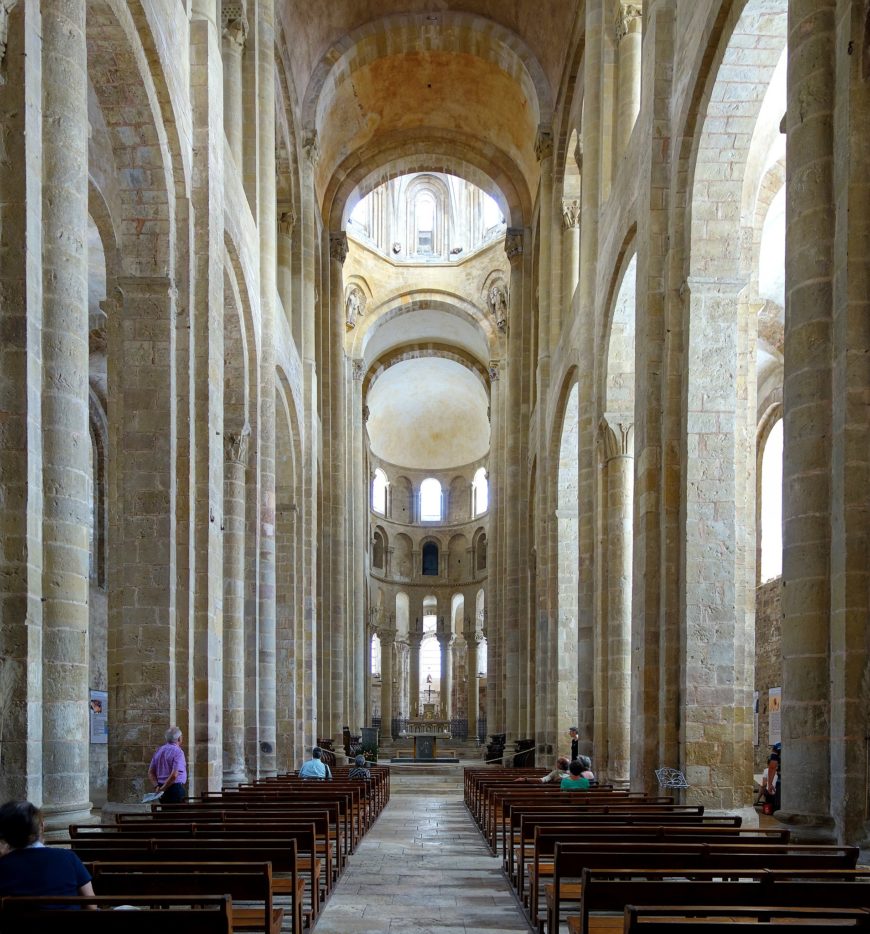
Church building of Sainte‐Foy, Conques, France, c. 1050–1130 (photograph: Velvet, CC BY-SA 4.0)
It is known as a pilgrimage church because many of the large churches along the route to Santiago de Compostela took a similar shape. The main feature of these churches was the cruciform plan. Not but did this programme have the symbolic form of the cantankerous but it likewise helped control the crowds of pilgrims. In almost cases, pilgrims could enter the western portal and then circulate effectually the church towards the apse at the eastern end. The apse commonly contained smaller chapels, known equally radiating chapels, where pilgrims could visit saint's shrines, especially the sanctuary of Saint Foy. They could then circulate around the ambulatory and out the transept, or crossing. This design helped to regulate the flow of traffic throughout the church although the intention and constructive employ of this blueprint has been debated.
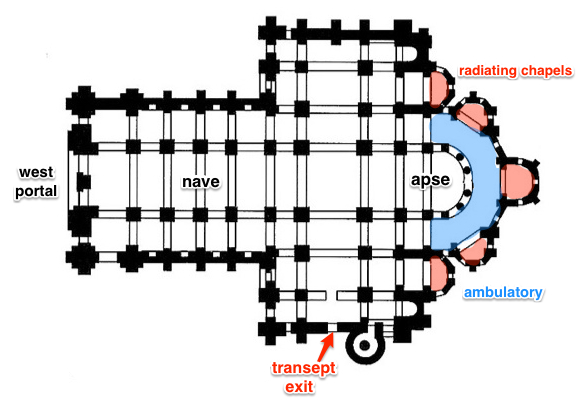
Programme, Church building of Sainte‐Foy, Conques, France, c. 1050–1130 C.Eastward. (adjusted)
A warning in stone: The tympanum of the Last Judgment
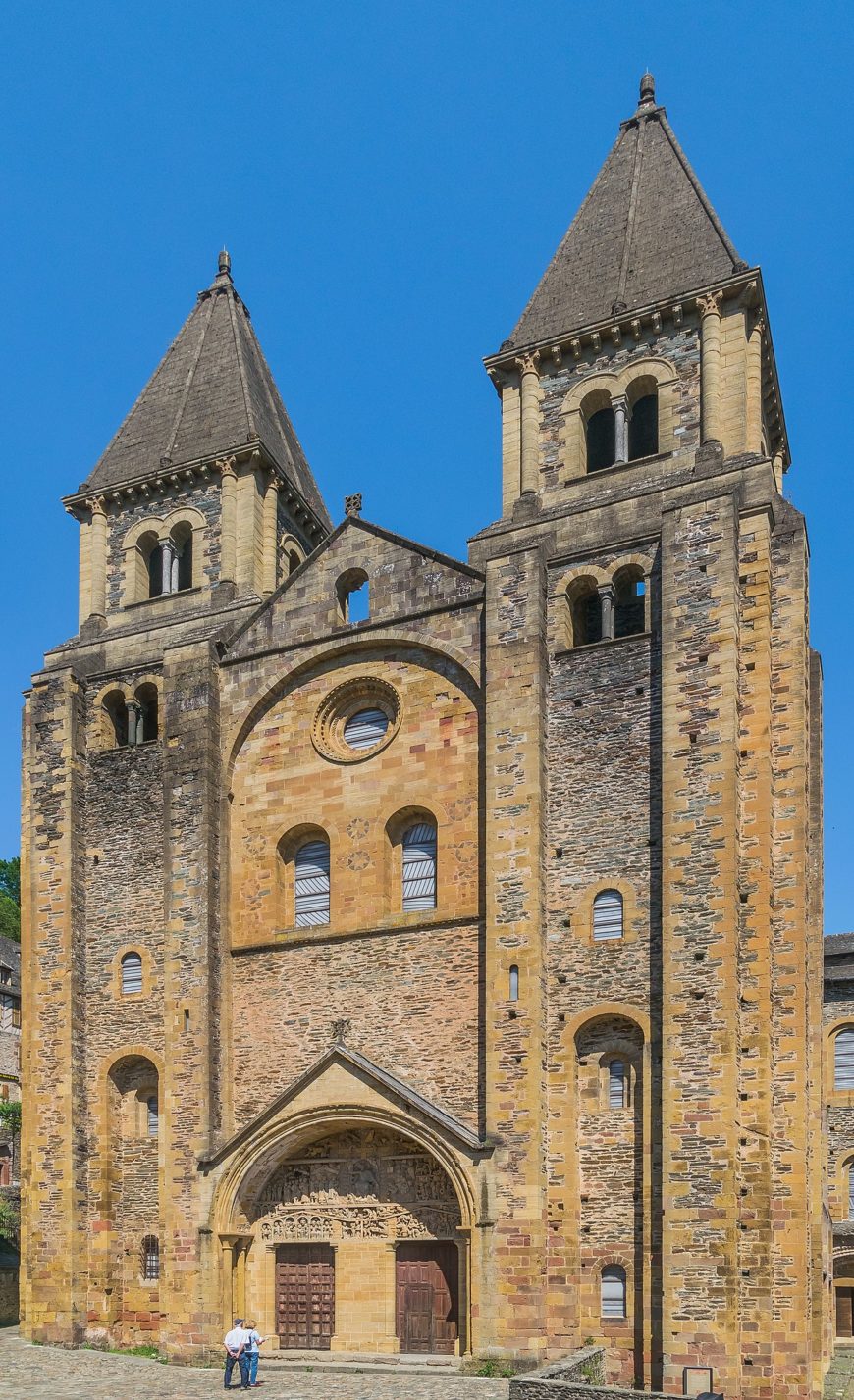
Church of Sainte‐Foy, Conques, France, c. 1050–1130 C.E. (photo:Tournasol7, CC Past-SA iv.0)
When a pilgrim arrived at Conques, they would probably head for the church to receive blessing. Withal earlier they got inside, an of import message awaited them on the portals: the Last Judgment. This scene is depicted on the tympanum, the central semi-circular relief carving above the central portal.
In the center sits Christ every bit Judge, and he means business! He sits enthroned with his right hand pointing upwards to the saved while his left paw gestures down to the damned. This scene would take served as a reminder to those entering the Church of Saint-Foy about the joys of heaven and torments of hell. Immediately on Christ's right are Mary, Peter and mayhap the founder of the monastery likewise as an entourage of other saints.
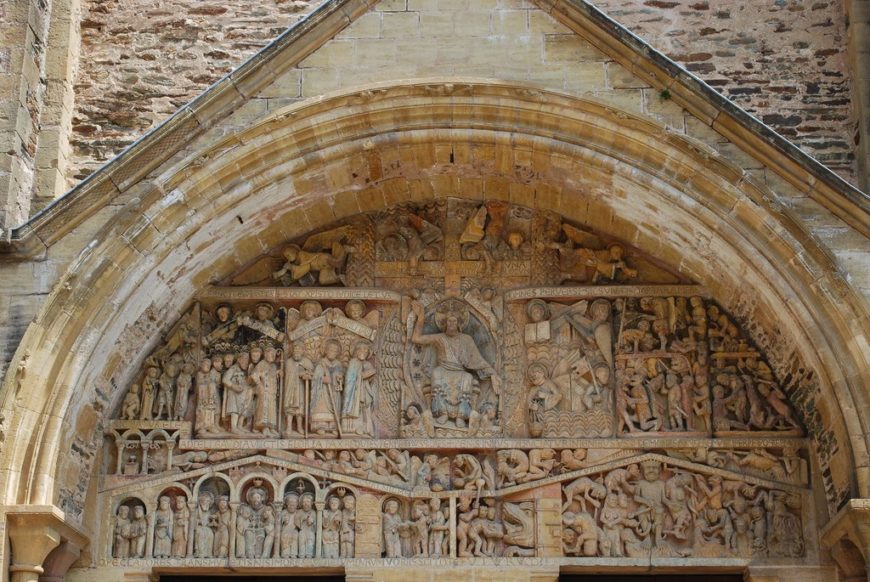
Concluding Judgment tympanum, Church building of Sainte‐Foy, France, Conques, c. 1050–1130 (photo: Òme deu Teishenèir, CC Past-SA 2.0)
Below these saints, a minor arcade is covered by a pediment, meant to represent the Firm of Paradise. These are the blest, those have been saved by Christ and who volition remain in Paradise with him for eternity. At the center, nosotros find Abraham and in a higher place him find the outstretched hand of God, who beckons a kneeling Saint Faith (run into epitome below).
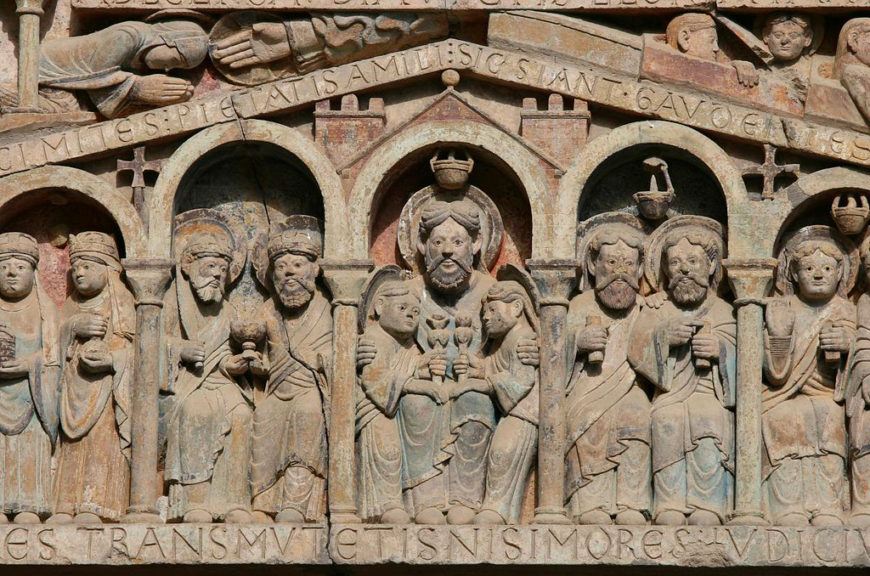
The blest in paradise, with the hand of God above beckoning Saint Foy (Saint Religion) (detail), Final Judgment tympanum, Church of Sainte‐Foy, French republic, Conques, c. 1050–1130 (photograph: Holly Hayes, CC BY-NC ii.0)
On the other side of the pediment, a row of angels opens the graves of the expressionless. As the dead rising from their tombs, their souls will be weighed and they will be admitted to sky or hell. This is the scene that nosotros meet right under Christ's feet—you can see the clear division between a large doorway leading to Paradise and a terrifying mouth that leads the way to Hell.
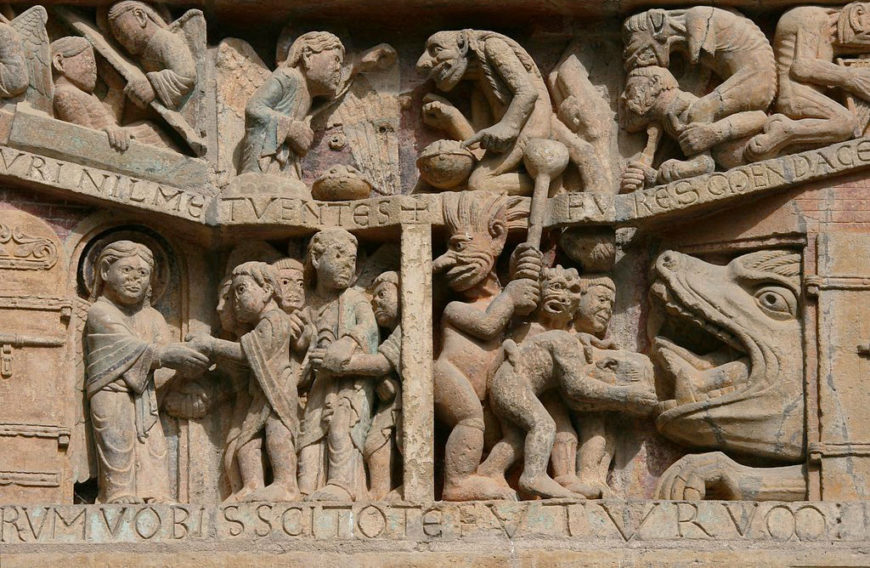
The gates of heaven and the oral fissure of hell (detail), Last Judgment tympanum, Church of Sainte‐Foy, France, Conques, c. 1050–1130 (photo: Holly Hayes, CC Past-NC 2.0)
Inside Hell, things aren't looking very good. It is a chaotic, disorderly scene—notice how different information technology looks from the right-paw side of the tympanum. There is also a pocket-sized pediment in the lower register of Hell, where the Devil, only reverse to Abraham, reigns over his terrifying kingdom.
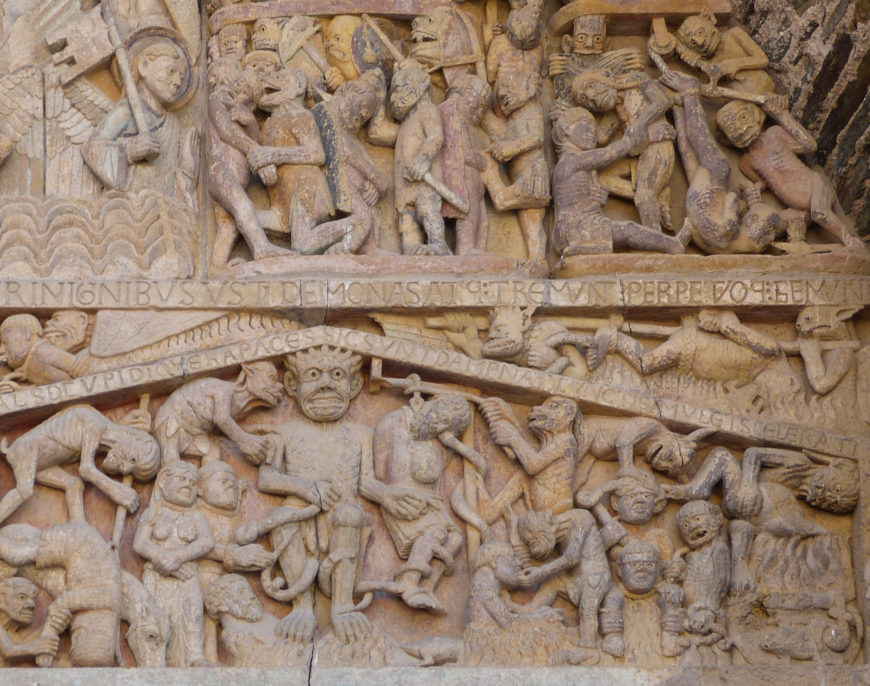
Hell (detail), Last Judgment tympanum, Church building of Sainte‐Foy, France, Conques, c. 1050–1130 (photo: ricardo, CC Past 2.0)
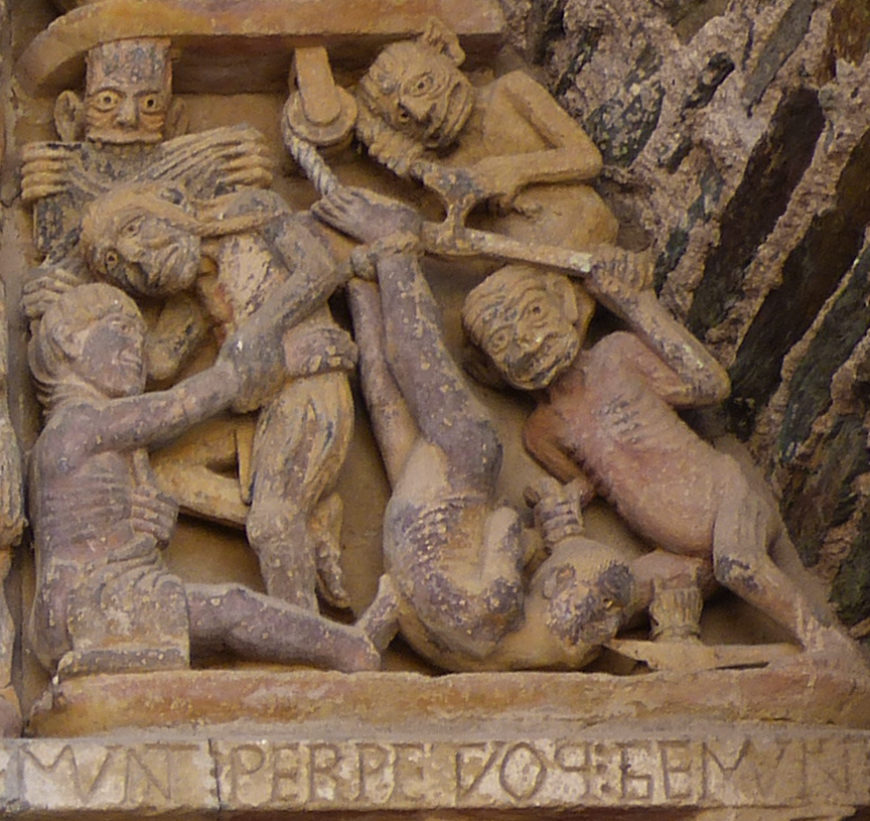
A epicurean homo, particular of the Last Judgment tympanum, Church of Sainte‐Foy, French republic, Conques, c. 1050–1130 (photo: ricardo, CC BY ii.0)
The devil, like Christ, is besides an enthroned approximate, determining the punishments that await the damned according to the severity of their sins. In particular, to the devil'due south left is a hanged human being. This man is a reference to Judas, who hanged himself later on betraying Christ. Merely beyond Judas, a knight is tossed into the fires of Hell and above him, a gluttonous man is hung by his legs for his sins. Each of these sinners represents a type of sin to avoid, from adultery, to arrogance, even to the misuse of church offices. Indeed, this portal was not simply a alert for pilgrims, but for the clergy who lived in Conques as well.
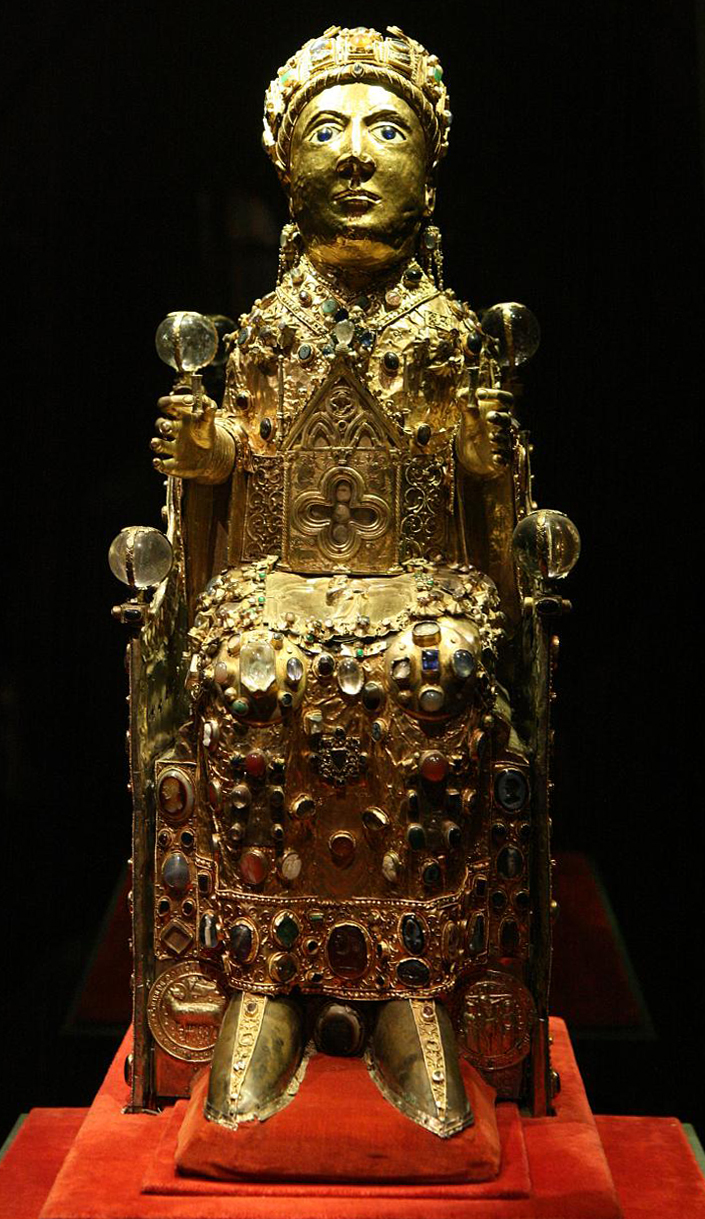
Reliquary statue of Sainte-Foy (Saint Faith), late 10th to early on 11th century with later additions, gold, silver gilt, jewels, and cameos over a wooden core, 33 ane/2 inches (Treasury, Sainte-Foy, Conques) (photo: Holly Hayes, CC Past-NC two.0)
The reliquary
Pilgrims arriving in Conques had one thing on their mind: the reliquary of Saint Foy. This reliquary, or container holding the remains of a saint or holy person, was one of the near famous in all of Europe. Then famous that information technology was originally located in a monastery in Agen but the monks at Conques plotted to steal it in order to attract more wealth and visitors. The reliquary at Conques held the remains of Saint Foy, a young Christian convert living in Roman-occupied French republic during the second century. At the age of twelve, she was condemned to die for her refusal to sacrifice to pagan gods, she is therefore revered equally a martyr, equally someone who dies for their faith. Saint Foy was a very popular saint in Southern France and her relic was extremely important to the church; bringing pilgrims and wealth to the small-scale, isolated town of Conques.
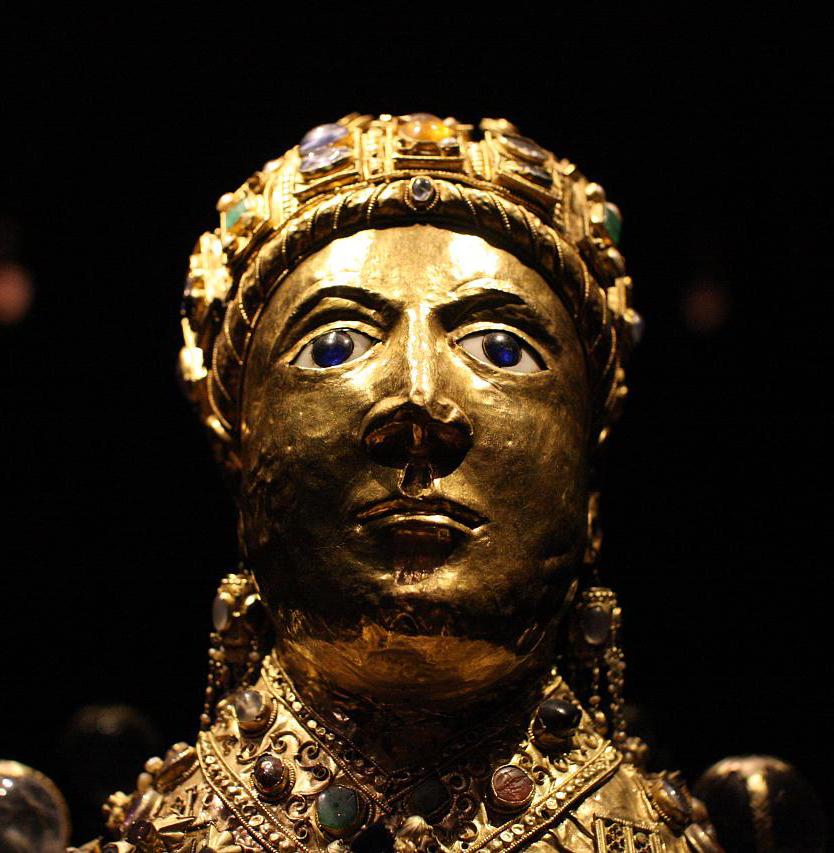
Head (item), Reliquary statue of Sainte-Foy (Saint Organized religion), late 10th to early on 11th century with after additions, gold, argent gilded, jewels, and cameos over a wooden core, 33-ane/2 inches (Treasury, Sainte-Foy, Conques) (photo: Holly Hayes, CC BY-NC 2.0)
While the date of the reliquary is unknown, Bernard of Angers commencement spoke it almost in 1010. At first, Bernard was frightened that the statue was as well cute stating, "Brother, what exercise you remember of this idol? Would Jupiter or Mars consider himself unworthy of such a statue?" He was concerned about idolatry—that pilgrims would begin to worship the jewel-encrusted reliquary rather than what that reliquary contained and represented, the holy figure of Saint Foy. Indeed, the gold and jewel encrusted statue would been quite a sight for the pilgrims. Over fourth dimension, travelers paid homage to Saint Foy by donating gemstones for the reliquary so that her dress is covered with agates, amethysts, crystals, carnelians, emeralds, garnets, hematite, jade, onyx, opals, pearls, rubies, sapphires, topazes, antiquarian cameos and intaglios. Her face, which stares boldly at the viewer, is idea to have originally been the head of a Roman statue of a child. The reuse of older materials in new forms of fine art is known as spolia. Using spolia was not only applied just information technology made the object more than important past associating information technology with the past riches of the Roman Empire.
The Church of Saint Foy at Conques provides an excellent example of Romanesque art and compages. Although the monastery no longer survives, the church and treasury stand equally a reminder of the rituals of medieval religion, peculiarly for pilgrims. Even today, people make the long expedition to Conques to pay respect to Saint Foy. Every Oct, a great celebration and procession is held for Saint Foy, continuing a medieval tradition into present mean solar day devotion.
Additional resources:
Sainte-Foy at Conques on Mapping Gothic French republic (Columbia University)
Gigapixel image of the Tympanum on Mapping Gothic France (Columbia University)
Relics and reliquaries in Medieval Christianity (The Met)
Toman, Rolf, and Achim Bednorz,Romanesque: architecture, sculpture, painting (Köln: Könemann, 1997).
Pamela Sheingorn, Robert L. A. Clark, and Bernardus,The Book of Sainte Foy (Philadelphia: University of Pennsylvania Press, 1995).
Janetta Rebold Benton, Art of the Middle Ages (New York, North.Y.: Thames & Hudson, 2002).
truchanasfrearpok.blogspot.com
Source: https://smarthistory.org/church-and-reliquary-of-sainte%E2%80%90foy-france/